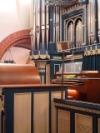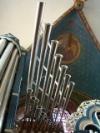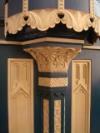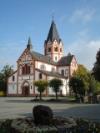Ausführliche Beschreibung der vorgewählten Orgel
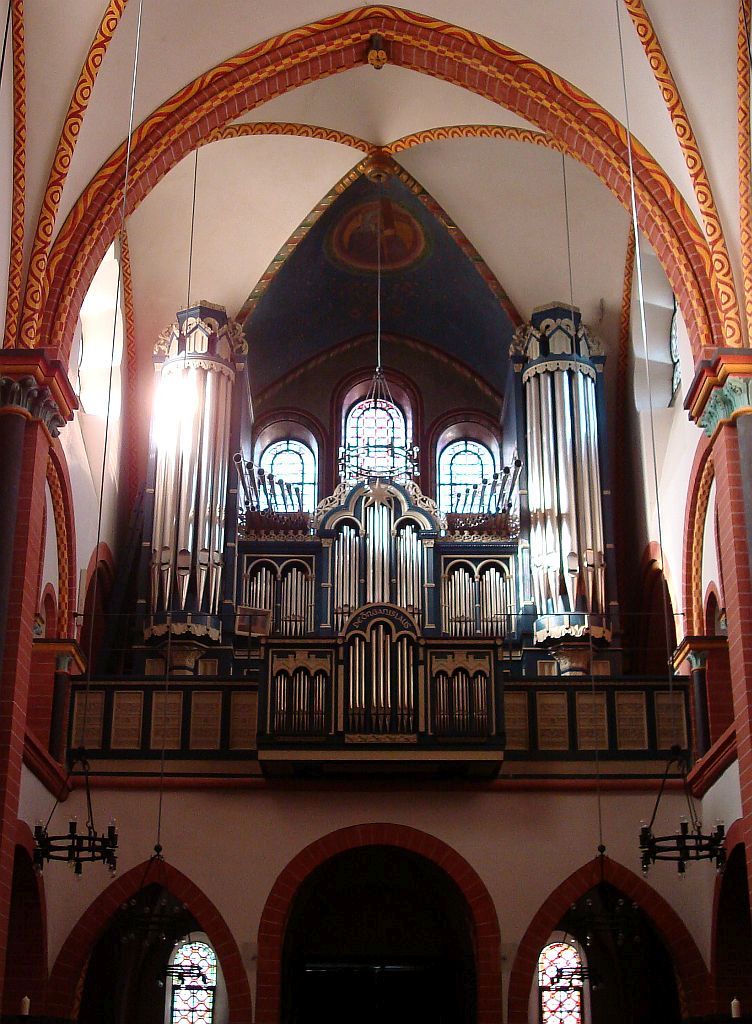
Bild: Tjalling Roosjen
Sinzig am Rhein, Deutschland (Rheinland-Pfalz) - Katholische Pfarrkirche Sankt Peter
Gemeinde: Sinzig am Rhein
Adresse: Zehnthofstraße 11, 53489, Sinzig am Rhein
Website: http://www.kath-kirche-sinzig.org/
Beschreibung nr.: 2000643.
Gebaut von: E.F. Walcker & Cie. (1972) - Opus 5295
Die Orgel enthält älteren Material: aus 1880 von H.W. Breidenfeld & Söhne
Technische Daten
Disposition
Hauptwerk (C-c''''): Pommer 16', Hohlpfeife 8', Spillpfeife 8', Principal 8', Octave 4', Spitzgambe 4', Nasard 2 2/3', Schweitzerpfeife 2', Mollterz 16/19', Oberton 2-4 fach (3 1/5'), Mixtur 5 fach (2'), Cymbel 5 fach (1/4'), Französische Krummhorn 16', Trompete 8', Röhrenglockenton 8' (C-f') - tubular bells, Harfe (fis'-c'''') - metal bars.
Rückpositiv (C-c''''): Quintade 8', Stillgedackt 8', Principal 4', Flauto Dolce 4', Nachthorn 2', Quinte 1 1/3', Fünfzehnte 8/15', Scharff 4 fach (1'), Dulzianregal 8', Xylophon 4', Tremulant.
Brustwerk (Schwellbar) (C-c''''): Holzgedackt 8', Rohrflöte 4', Principal 2', Terz 1 3/5', Blockflöte 1', Oberton 2 fach (1 1/7'), Cymbel 2 fach (1/2'), Harfenregal 16', Schalmey 4', Tremolo - adjustable speed, Psalterium (C-c'''').
Trompeteria (1992, no longer present) (C-c''''): Mixtur 5-8 fach (1 1/3'), Trompeta Magna 16' - en chamade, Trompeta de Batalla 8' - en chamade, Clarín Brillante 4' - en chamade.
Pedal (C-g'): Subbaß 16', Principal 16', Octavbaß 8', Violoncello 8', Quintgedackt 5 1/3', Octave 4', Gemshorn 2', Hintersatz 3 fach (2'), Theorbe 3 fach (6 2/5'), Dulcian 32', Bombarde 16', Fagott 8', Trompetenregal 4'.
Sonstige Register: Cymbelstern, Percussion.
Koppeln: Hauptwerk - Rückpositiv, Hauptwerk - Brustwerk, Rückpositiv - Brustwerk, Pedal - Hauptwerk, Pedal - Rückpositiv, Pedal - Brustwerk.
Nebenregister und Spielhilfen: 3 freie Kombinationen, Tastenfessel, Registermanual, Mixturensetzer, Tutti, Windrossel (Hauptwerk en Brustwerk).
YouTube
Wie Verrückt Ist Diese Orgel? / Fraser Gartshore (2019)

Bild: Tjalling Roosjen
Sinzig am Rhein, Deutschland (Rheinland-Pfalz) - Katholische Pfarrkirche Sankt Peter
Gemeinde: Sinzig am Rhein
Adresse: Zehnthofstraße 11, 53489, Sinzig am Rhein
Website: http://www.kath-kirche-sinzig.org/
Beschreibung nr.: 2000643.
Gebaut von: E.F. Walcker & Cie. (1972) - Opus 5295
Die Orgel enthält älteren Material: aus 1880 von H.W. Breidenfeld & Söhne
| Jahr | Orgelbauer | Opus | Aktivität | 1880 | H.W. Breidenfeld & Söhne | Neubau | 1972 | E.F. Walcker & Cie. | 5295 | Neubau im alten Gehäuse | 1979 | E.F. Walcker & Cie. | Vergrößerung | 2019 | Klais Orgelbau | Restaurierung |
- In 1880, the company Gebrüder Breidenfeld from Trier built a new organ in romantic style for the church of Sankt Peter in Sinzig am Rhein. The company Walcker built a new organ in 1971-1972, using parts of the Breidenfeld instrument.
- The Walcker organ in Sinzig am Rhein is a curious attempt to create a modern organ with its own twentieth century sound. The stop list was designed by Peter Bares, then Church organist. Striking are the many strange mixtures, such as the Oberton of the Hauptwerk, composed of thirds, quints, octaves and sevenths. The Cymbel also has a remarkable composition. The register Rohrenglockenton is a Carillon consisting of metal bars. The Psalterium consists of brass plates that are struck with electrically driven hammers. Another percussion instrument is the xylophone. The speed of the tremulant is adjustable, and there is also a drumset with adjustable rhythm. The organ was inaugurated on June 25, 1972.
- In 1979 the organ was expanded with a Trompeteria, which is located on a gallery on the south side. It was playable from the third manual or from a local keyboard. This Trompeteria was owned by Peter Bares. In 1992 Bares became organist of the Sankt Peterkirche in Cologne. He took the Trompetaria with him.
- The company Klais overhauled and restored the organ in Spring 2019. There were no modifications to the sound or stop list done.
Technische Daten
| Anzahl Register pro Manual | |
| - Hauptwerk | 16 |
| - Rückpositiv | 10 |
| - Brustwerk | 10 |
| - Trompeteria | 4 |
| - Pedal | 13 |
| Gesamtzahl der Stimmen | 53 |
| Tastentraktur | Mechanical |
| Registertraktur | Electrical |
| Windlade(n) | Slider chests |
Disposition
Hauptwerk (C-c''''): Pommer 16', Hohlpfeife 8', Spillpfeife 8', Principal 8', Octave 4', Spitzgambe 4', Nasard 2 2/3', Schweitzerpfeife 2', Mollterz 16/19', Oberton 2-4 fach (3 1/5'), Mixtur 5 fach (2'), Cymbel 5 fach (1/4'), Französische Krummhorn 16', Trompete 8', Röhrenglockenton 8' (C-f') - tubular bells, Harfe (fis'-c'''') - metal bars.
Rückpositiv (C-c''''): Quintade 8', Stillgedackt 8', Principal 4', Flauto Dolce 4', Nachthorn 2', Quinte 1 1/3', Fünfzehnte 8/15', Scharff 4 fach (1'), Dulzianregal 8', Xylophon 4', Tremulant.
Brustwerk (Schwellbar) (C-c''''): Holzgedackt 8', Rohrflöte 4', Principal 2', Terz 1 3/5', Blockflöte 1', Oberton 2 fach (1 1/7'), Cymbel 2 fach (1/2'), Harfenregal 16', Schalmey 4', Tremolo - adjustable speed, Psalterium (C-c'''').
Trompeteria (1992, no longer present) (C-c''''): Mixtur 5-8 fach (1 1/3'), Trompeta Magna 16' - en chamade, Trompeta de Batalla 8' - en chamade, Clarín Brillante 4' - en chamade.
Pedal (C-g'): Subbaß 16', Principal 16', Octavbaß 8', Violoncello 8', Quintgedackt 5 1/3', Octave 4', Gemshorn 2', Hintersatz 3 fach (2'), Theorbe 3 fach (6 2/5'), Dulcian 32', Bombarde 16', Fagott 8', Trompetenregal 4'.
Sonstige Register: Cymbelstern, Percussion.
Koppeln: Hauptwerk - Rückpositiv, Hauptwerk - Brustwerk, Rückpositiv - Brustwerk, Pedal - Hauptwerk, Pedal - Rückpositiv, Pedal - Brustwerk.
Nebenregister und Spielhilfen: 3 freie Kombinationen, Tastenfessel, Registermanual, Mixturensetzer, Tutti, Windrossel (Hauptwerk en Brustwerk).
| Gemischte Stimme | Zusammensetzung |
| Mixtur 5 fach (Hauptwerk) | C: 2' - 1 1/3' - 1' - 2/3' - 1/2'. G: 2' - 1 1/3' - 1' - 1' - 2/3'. d°: 2 2/3' - 2' - 1 1/3' - 1' - 2/3'. a°: 2 2/3' - 2' - 2' - 1 1/3' - 1'. e': 4' - 2 2/3' - 2' - 1 1/3' - 1'. b': 4' - 2 2/3' - 2' - 2' - 1 1/3'. fis'': 8' - 4' - 2 2/3' - 2' - 1 1/3'. d''': 8' - 4' - 2 2/3' - 2 2/3' - 2'. |
| Cymbel 5 fach (Hauptwerk) | C: 1/4' - 4/21' - 2/13' - 2/17' - 1/10'. F: 1/4' - 4/17' - 1/5' - 4/21' - 2/13'. c°: 1/2' - 8/21' - 4/13' - 4/17' - 2/10'. f°: 1/2' - 8/17' - 2/5' - 8/21' - 4/13'. c': 1' - 16/21' - 8/13' - 8/17' - 2/5'. f': 1' - 16/17' - 4/5' - 16/21' - 8/13'. c'': 2' - 1 11/21' - 1 3/13' - 16/17' - 4/5'. f'': 2' - 1 15/17', 1 3/5' - 1 11/21' - 1 3/13'. c''': 4' - 3 1/21' - 2 6/13' - 1 15/17' - 1 3/5'. f''': 4' - 3 13/17' - 3 1/5' - 3 1/21' - 2 6/13'. |
| Oberton 2-4 fach (Hauptwerk) | C: 3 1/5' - 1'. G: 3 1/5' - 1 7/9' - 1'. c°: 5 1/3' - 3 1/5' - 1 7/9' - 1'. |
| Scharff 4 fach (Rückpositiv) | C: 1' - 2/3' - 1/2' - 1/3'. Bes°: 1 1/3' - 1' - 2/3' - 1/2'. gìs°: 2' - 1 1/3' - 1' - 2/3'. fis': 2 2/3' - 2' - 1 1/3' - 1'. e'': 4' - 2 2/3' - 2' - 1 1/3'. d''': 4' - 2 2/3' - 2' - 2'. |
| Cymbel 4 fach (Brustwerk) | C: 1/2' - 1/3' - 1/4' - 1/6'. Gìs°: 2/3' - 1/2' - 1/3' - 1/4'. e°: 1' - 2/3' - 1/2' - 1/3'. cis': 1 1/3' - 1' - 2/3' - 1/2'. b': 2' - 1 1/3' - 1' - 2/3'. g'': 2 2/3' - 2' - 1 1/3' - 1'. e''': 4' - 2 2/3' - 2' - 1 1/3'. |
| Oberton 2 fach (Brustwerk) | C: 1 1/7' - 8/11'. g'': 1 5/11' - 1 1/7'. d''': 2 2/7' - 1 5/11'. g''': 2 10/11' - 2 2/7'. |
| Mixtur 5-8 fach (Trompeteria) | C: 2 2/3' - 2' - 1 1/3' - 1 1/7' - 4/5'. A: 4' - 2 2/3' - 2' - 1 1/3' - 1 1/7' - 4/5'. fìs°: 4' - 2 2/3' - 2' - 1 3/5' - 1 1/3' - 1 1/7'. cis': 5 1/3' - 4' - 2 2/3' - 2' - 1 3/5' - 1 1/7'. gis': 8' - 5 1/3' - 4' - 2 2/3' - 2' - 1 3/5' - 1 1/7'. dis'': 8' - 8' - 5 1/3' - 4' - 2 2/3' - 2 2/7' - 1 3/5' - 1 1/3'. a''': 8' - 8' - 5 1/3' - 4' - 4' - 2 2/3' - 2 2/7' - 1 3/5'. |
| Hintersatz 3 fach (Pedal) | C: 2' - 1 1/3' - 1'. |
| Theorbe 3 fach (Pedal) | C: 6 2/5' - 4 4/7' - 2 2/3'. |
| Literatur |
|
| Weblinks |
https://orgelbau-klais.com/m.php?sid=492 |




